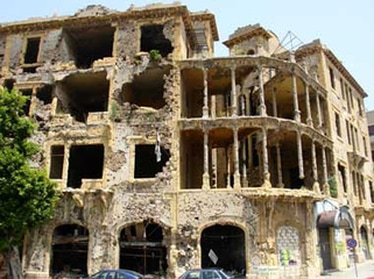
1975: On 13 April, members of the Phalangist militia open fire on a busload of Palestinians in the Beirut area of Ain el-Remmaneh, marking the start of the Lebanese Civil War. Slowly, all sects and classes of Lebanon are drawn into the conflict, either as participants or as victims. Eventually, neighboring countries are drawn in as well. During this year, the start of Syrian interference becomes more pronounced.
1976: As a result of skirmishes between the different factions positioned in East and West Beirut, a dividing line takes shape, separating the Christians (East Beirut) from the Muslims (West Beirut).
This line eventually becomes known as the Green Line due to the vegetation that sprouts up in this uninhabited area. One of the few groups that remain downtown is the Jewish community. In April, the PLO and its Lebanese allies manage to take control of large portions of Lebanon and threaten to take control of the whole country. In June, Syrian troops, as part of the peacekeeping Arab Deterrent Force (ADF), which had initially supported the PLO, enter Lebanon to prevent the Christian side from being overrun by the PLO. Soon, the Syrian army becomes the strongest party in the country. Cross-border attacks between PLO and Israel in the south of Lebanon continue unabated.
1978: The Lebanese Forces (LF), an alliance of the various right-wing Christian party militias led by the Phalangists, join the side of Israel, while the PLO and its Lebanese allies revert to their partnership with Syria. The Shi’ite Amal Movement, formed in 1975, takes up its weapons against the PLO and its allies, bringing in a third side to the battle. Under the name Operation Litani, Israel invades the south of Lebanon for the first time in order to destroy PLO military infrastructure all the way up the Litani River, 30 kilometers away from the border. The UN Interim Force in Lebanon (UNIFIL), a multinational peacekeeping force, is sent into the south of Lebanon under UN Resolution 425. As part of this resolution, Israel is obliged to withdraw completely from the south of Lebanon. Yet, it only withdraws to a 12 kilometers security zone manned by the South Lebanon Army (SLA), a Lebanese militia sympathetic to Israel. The Syrian army engages in fighting with the Lebanese Forces in East Beirut as it enters into previously unoccupied areas throughout the country.1982: In a bid to remove the PLO from Lebanon and diminish the Syrian presence, the alliance between the Lebanese Forces and Israel is strengthened, culminating in Israel’s ‘Operation Peace for Galilee’, a full-scale invasion of the south of Lebanon, and later Beirut. Within two months, around 20,000 people are killed and Beirut is left in ruins. After pressure from the US, the PLO and Yasser Arafat leave Lebanon and the UN requests the withdrawal of all non-Lebanese forces from Lebanon. Bashir Gemayel, the leader of the Phalangist militia and the Lebanese Forces, is elected president in August 1982, only to be assassinated three weeks later. Presumably in revenge for the assassination, members of the Lebanese Forces militia, with the help of Israel, kill about 2,000 Palestinian men, women and children during a three-day massacre in two of Beirut’s Palestinian refugee camps, Sabra and Shatila. Following this tragedy, a Western Multi-National Force, constituted mainly by US soldiers, is deployed to Beirut. Amin Gemayel succeeds his brother Bashir as president. During this year, Hezbollah’s resistance against the Israeli occupation of Lebanon starts in the south (see text box).
1983: As the US becomes more embroiled in the war, hostility to its interference and the country’s perceived support for Israel grows, manifesting itself in suicide attacks targeting the US Embassy and attacks on US and French military headquarters. Additionally, a kidnapping and assassination campaign begins against American officials and civilians, as well as other westerners, which continues until 1986. Under the auspices of an agreement with the Lebanese government, widely criticized by the Lebanese population, Israel withdraws from Beirut to the south of Lebanon. Subsequently, fighting in the Shouf Mountains between the Druze (supported by the PLO) and the Lebanese Forces starts in retaliation for the latter’s support of Israel. In the meantime, Syrian troops, still in the country, try to overthrow the Lebanese government and the US starts bombing Syrian and Druze army positions. In December 1983, the PLO finally leaves Lebanon from Tripoli, after the Israelis subject the city to aerial bombing.
1984: US Marines withdraw from Lebanon to American naval vessels off Beirut’s shore. In March, under pressure from the public as well as regional countries, Lebanon annuls the Lebanese-Israeli Treaty of May 1983.
1985: Continuing with its heavy-handed practices against the population in the south of Lebanon, Israel transfers about 1,200 (mainly Shi’ite) prisoners from the Ansar prison to a prison in Israel. Following its withdrawal from the major coastal cities in the south, Israel establishes a security zone along the border, an occupation that continues until 2000. Pressure on Israeli troops and the SLA continues as resistance operations conducted by Hezbollah become more pronounced.
1986 - 1987: Heavy fighting, arrests and assassinations continue.
1988: Fighting begins between the two Shi’ite factions, Amal and Hezbollah, in the south of Lebanon and the southern suburbs of Beirut, lasting for nearly two months. Israeli fighter planes bomb the Palestinian refugee camp near Saida, claiming that the PLO is regrouping in the camp. President Amin Gemayel, just before his term expires and with parliament unwilling to vote in a successor, creates an alternative power structure to his own government by appointing a six-man military government, led by Lebanese Army chief Michel Aoun.
1989: In January, Amal and Hezbollah agree to a ceasefire to end their escalating conflict. Heavy fighting between Aoun’s Lebanese Army and the Lebanese Forces erupts. Fighting in the south of Lebanon between Israel and Hezbollah continues. General Michel Aoun begins the War of Liberation against the Syrian army positions in Lebanon, resulting in an escalation of fighting within Beirut. In November, the Taif Accord* of the Arab League is ratified by the National Assembly. As President Aoun opposes the accord, René Moawad, a Maronite Christian, becomes the country’s new president. After he is assassinated two weeks later, pro-Syrian Elias Hrawi takes his place and establishes a new government.
1990: On 13 October 1990, when formal President Aoun is deposed by Syrian Forces, the Civil War comes officially to an end. Israeli attacks on the south of Lebanon continue.

